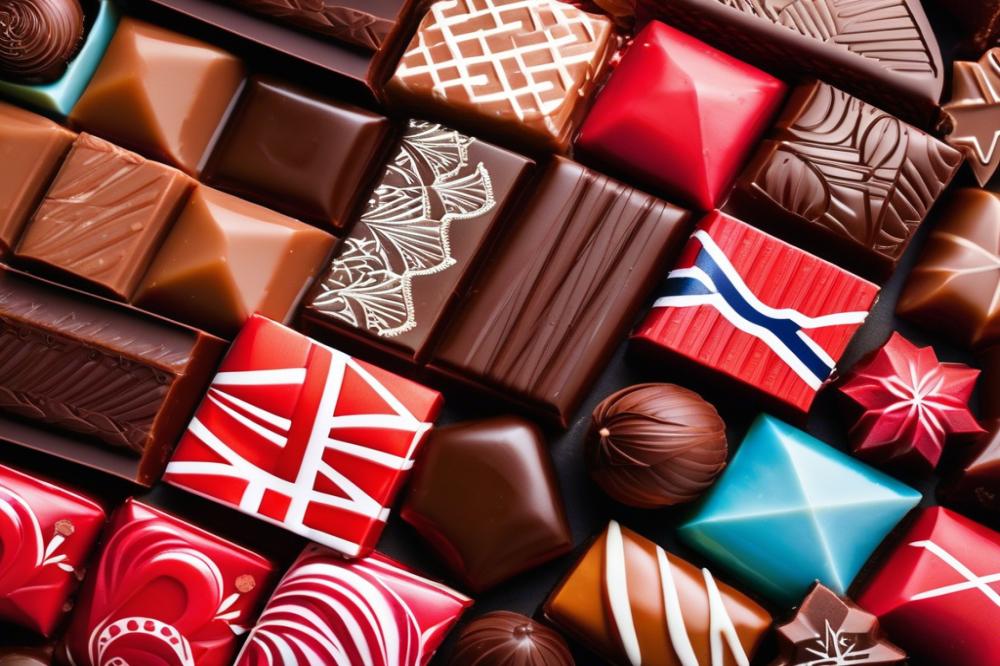Introduction
Chocolate holds a significant place in Norwegian culture. It not only serves as a popular treat but also reflects the values and tastes of the population. Throughout the years, chocolate has evolved from a luxury item to an everyday pleasure for many. In fact, chocolate consumption per capita in Norway ranks among the highest in Europe. This prominence emphasizes the importance of chocolate to the Norwegian palate.
Several Norwegian chocolate brands have emerged, gaining recognition both domestically and internationally. Companies like Freia and Nidar are household names, yet a wave of artisan chocolate makers has changed the landscape. These artisans prioritize quality and often focus on sustainable chocolate methods. This dedication resonates with consumers looking for fair trade chocolate options, which address ethical concerns surrounding cocoa sourcing.
The chocolate culture in Norway is rich and varied. Annual chocolate festivals celebrate this beloved sweet, showcasing local talents and innovative recipes. Attendees can indulge in tastings, workshops, and even learn the art of making their own chocolate. Such events foster a community feeling, connecting people over their shared love for sweets.
As trends shift, Norway chocolate trends reveal a growing focus on health and sustainability. Consumers increasingly seek products that not only satisfy their sweet tooth but also align with their values. Thus, preferences have started to shift towards dark chocolate and organic options. Local chocolatiers have responded, often experimenting with Nordic chocolate flavors that highlight local ingredients.
In conclusion, the evolution of chocolate in Norway reflects both historical influences and modern demands. As the market continues to grow, the blend of tradition and innovation keeps the future of Norwegian chocolate exciting.
Norway chocolate trends

chocolate consumption in Norway reflects a rich and ever-evolving culture. Over the years, people in this country have enjoyed various forms of chocolate. Traditional Norwegian chocolate brands have established strong footholds in the market. However, recent trends indicate a shift. More consumers are looking for unique flavors and ethically sourced ingredients.
Analysis of Shifts in Consumer Preferences
The past decade has seen notable changes in how Norwegians view chocolate. Increasing awareness surrounding health and wellness has influenced choices. Many are seeking darker chocolate with higher cocoa content. This preference aligns with global trends promoting quality over quantity. Consumers are less interested in mass-produced sweets. Instead, they seek more tailored experiences, favoring premium products.
Rise of Artisan Chocolate and Local Brands
Local artisans are making their mark in the chocolate scene. A variety of small brands are popping up across Norway. These artisans focus on blending traditional methods with modern creativity. Their offerings often feature local ingredients, which enhances regional flavors. Chocolate festivals held annually showcase these impressive creations. The popularity of these events highlights a growing appreciation for gourmet chocolate. Buyers are now fully engaged with the narratives that accompany each brand.
Discussion on Fair Trade Chocolate Initiatives
Fair trade chocolate is becoming increasingly relevant in Norway’s chocolate culture. Consumers are more aware of where their cocoa is sourced from. Many prioritize brands that support sustainable farming practices. This initiative not only aids farmers but also improves the overall quality of the chocolate. Knowing that their purchases contribute to a good cause makes buyers feel empowered. As a result, fair trade products are gaining traction alongside artisan chocolates.
In addition to ethical sourcing, Norwegians are exploring diverse chocolate recipes at home. Creative cooking allows individuals to experiment with various flavors. Integrating local ingredients into these recipes adds another layer of richness. Chocolate contests also encourage innovation and playfulness among home bakers.
The future of chocolate in Norway appears bright. As artisanal brands thrive and awareness of sustainability grows, consumer preferences will likely continue shifting. As trends evolve, the landscape of chocolate consumption in Norway will undoubtedly transform further.
Historical Evolution of Chocolate in Norway

Origins of Chocolate in Norway
Chocolate first arrived in Norway in the 17th century. Initially, it was a luxury item, considered the drink of the elite. Wealthy Norwegians enjoyed hot chocolate, often flavored with spices. Over time, interest grew, and chocolate became more accessible to the general public. By the 19th century, chocolate bars began to appear, marking a shift in how people consumed this beloved treat.
Key Historical Milestones Impacting Chocolate Consumption
The establishment of chocolate factories played a major role in transforming consumption patterns. Norway’s first chocolate factory opened in 1839. This milestone made chocolate widely available. As decades rolled on, brands like Freia emerged, further popularizing chocolate in Norwegian households. The launch of mass-produced chocolate allowed families to enjoy it regularly, not just on special occasions.
Influence of Global Events on Norwegian Chocolate Culture
World events have left their mark on Norwegian chocolate culture. The two World Wars caused shortages, leading to creative adaptations. During these times, Norwegian chocolatiers began experimenting with local flavors. Products showcased unique ingredients, such as berries and nuts, which reflected the local heritage. Fair trade chocolate initiatives also gained traction in the late 20th century, influenced by global movements advocating for ethical sourcing.
Transition from Traditional to Modern Chocolate Products
The chocolate scene has evolved significantly over recent years. Traditional brands still hold a place in many hearts, but artisan chocolate has gained popularity. Craft chocolate producers are now creating small batches with an emphasis on quality. These artisans focus on sustainable chocolate sourcing practices that respect environmental concerns. Chocolate festivals celebrate this shift, showcasing innovative recipes and unique flavors. As Norwegians embrace these modern trends, the landscape of chocolate consumption continues to thrive, blending history with contemporary tastes.
Norwegian Chocolate Brands
Norway boasts several prominent chocolate brands that reflect its rich chocolate culture. Among them, Freia stands out as an iconic name. This brand has been a part of Norwegian life since the early 1900s. They offer a range of products, from classic milk chocolate bars to innovative flavors. Another notable brand is Nidar, which excites taste buds with traditional sweets and seasonal treats.
Artisan chocolate companies have emerged recently, pushing the boundaries of flavor and texture. One such brand is Mellembakken, known for its handcrafted truffles. These small businesses often focus on quality. Their chocolates are made using methods that prioritize cocoa sourcing, ensuring a delightful experience for consumers.
Sustainability plays a key role for many Norwegian brands. Companies frequently emphasize fair trade chocolate, which supports farmers in cocoa-producing countries. This commitment helps create a more ethical chocolate market. Brands like Håndverkeren aim to combine quality artisan processes with environmental awareness.
Local chocolate festivals celebrate these brands and introduce new recipes to the public. These events showcase the creativity of chocolatiers, often providing tastings. Visitors can explore different flavors and learn about the historical evolution of chocolate in Norway. They also highlight how chocolate consumption has transformed over the years.
Moreover, the impact of local brands on the chocolate market cannot be underestimated. As consumers increasingly seek out sustainable chocolate, this trend drives larger companies to adapt. This competition can elevate overall quality, benefiting everyone involved, from the producers to consumers.
Sustainable Chocolate Practices
The importance of sustainable chocolate sourcing in Norway
Sourcing chocolate sustainably has become increasingly important in Norway. Norway’s chocolate scene reflects a growing awareness of environmental issues. This awareness is evident among consumers who prioritize products that do not harm the planet. Sustainable practices often begin with responsible cocoa sourcing. Chocolate brands are now more conscious of where their ingredients come from.
Norwegian efforts in promoting fair trade chocolate
Norwegian chocolate brands have taken steps to promote fair trade. Smaller artisan chocolate makers often emphasize ethical sourcing. They work directly with farmers to secure a fair price for cocoa beans. Many Norwegian consumers are now seeking fair trade certified options. This trend aligns with a broader push for social responsibility in the food industry.
Impact of environmental concerns on consumer choices
Environmental concerns significantly shape consumer choices in Norway. Many shoppers are now considering the eco-friendliness of products. This shift influences how brands market their chocolate. Packaging, production methods, and ingredient sourcing are crucial factors. Eco-conscious consumers often choose brands that highlight sustainable practices. A growing number of chocolate festivals celebrate these values, showcasing brands committed to sustainability.
Successful models of sustainable production in Norwegian chocolate
Several Norwegian chocolate brands serve as models for sustainable production. They often implement innovative practices in sourcing and harvesting cocoa. Many of these brands rely on partnerships with communities in cocoa-growing regions. This strategy supports local economies while securing high-quality ingredients. Recipe innovation often incorporates local flavors, further connecting chocolate to Norwegian culture. Such models inspire others in the industry to adopt similar sustainable chocolate practices.
Chocolate Festivals and Cultural Celebrations
Overview of Notable Chocolate Festivals in Norway
Norway hosts several chocolate festivals that attract chocolate lovers from around the region. One notable event is the Oslo Chocolate Festival, held annually in the capital. This festival showcases a wide array of chocolate products, including artisan chocolate from local producers. Attendees have the chance to explore various chocolate recipes and learn more about different types of chocolate.
Another popular festival takes place in Bergen, featuring a mix of local and international brands. Chocolate lovers gather to enjoy tastings and workshops. Various activities during these festivals often include discussions on cocoa sourcing and the importance of fair trade chocolate.
The Role of Festivals in Promoting Chocolate Culture
Festivals play a crucial role in enhancing the chocolate culture in Norway. They serve as platforms for education and celebration. Visitors learn about the historical evolution of chocolate consumption and its journey to modern days. Workshops often focus on sustainable chocolate practices and the significance of ethical sourcing.
These events highlight the artistry involved in creating Norwegian chocolate brands. Knowledge sharing from artisans fosters appreciation for the craft. As people engage, they gain a deeper understanding of how chocolate fits into Norwegian traditions.
Participation of Local Brands and Artisans in These Events
Local brands and artisans participate actively in these chocolate festivals. They showcase their products while sharing their stories about chocolate-making. Many small businesses use these events to launch new flavors or products. This engagement helps them connect directly with consumers and build a loyal customer base.
Artisans are often eager to provide samples and demonstrations. This direct involvement allows attendees to ask questions and become more familiar with local chocolate varieties. The intimate atmosphere of these festivals encourages a sense of community around chocolate lovers.
Public Reception and Community Engagement
The response from the public is overwhelmingly positive. Chocolate enthusiasts look forward to these celebrations each year. Families often attend together, enjoying the festive atmosphere. Activities such as chocolate tastings generally see high participation rates.
Community engagement also extends beyond festivals. Many participants feel inspired by what they learn and contribute to discussions about sustainable chocolate. Workshops and panels spark conversations about the significance of choosing fair trade chocolate. Those who visit often leave with a renewed passion for chocolate and a commitment to supporting local brands.
Chocolate Recipes and Innovations
Popular Chocolate Recipes Inspired by Norwegian Ingredients
Many popular chocolate recipes take inspiration from Norway’s rich natural resources. Berries are often mixed into dark chocolate, creating a delightful balance of flavors. The use of cloudberries and bilberries adds a unique twist to traditional chocolate treats. Norwegian chocolate brands have embraced these local ingredients, highlighting Icelandic sea salt or herbs that grow in the fjords. Cakes, truffles, and bars showcase these combinations, appealing to consumers seeking authentic flavors rooted in their culture. This trend has brought an increased appreciation for handmade, artisan chocolate.
Emergence of New Recipes Reflecting Modern Trends
Modern trends have also influenced chocolate consumption in Norway. There’s a noticeable rise in vegan and dairy-free choices, as more people seek healthier alternatives. Recipes incorporating nuts, seeds, and natural sweeteners are becoming popular. Additionally, flavors like matcha or chili pepper are often found in innovative chocolate confections. These adaptations meet the demands of a contemporary audience that values both taste and health. Local chefs and chocolatiers continually experiment, pushing the boundaries of what chocolate can be.
Culinary Fusion Within the Chocolate Industry
Fusion cuisine plays a significant role in today’s chocolate culture. Blending elements from various culinary traditions creates exciting new chocolate experiences. For example, Asian-inspired flavors have emerged, combining traditional Norwegian chocolate with matcha or yuzu. These creative recipes have garnered attention at chocolate festivals, where the exploration of diverse tastes keeps visitors eager to try new offerings. Alongside this, fair trade chocolate continues to be a priority, ensuring ethical sourcing and supporting cocoa farmers in developing countries.
The Role of Innovation in Maintaining Consumer Interest
Innovation is vital for keeping consumers engaged with chocolate. New techniques in cocoa sourcing and production can enhance flavor and texture. Brands invest in research to create sustainable chocolate options, appealing to eco-conscious shoppers. As a result, unique bars and bonbons often feature unusual ingredients or artistic presentations. The market thrives on creativity, driving chocolatiers to pursue new ideas. Engaging storytelling around ingredients and processes also enhances the overall appeal, inviting consumers to become part of a larger chocolate narrative.
Reflecting on Norway’s Chocolate Landscape
The fascinating journey of chocolate in Norway highlights a deep cultural connection. Early influences blended with local traditions shaped what many consider a rich part of Norwegian heritage. Over the years, chocolate consumption has varied dramatically, influenced by global trends and local tastes. It is evident that artisan chocolatiers have played a key role in this transformation, introducing flavors that are both innovative and nostalgic.
Current trends point towards an increasing focus on quality rather than quantity. This shift encourages consumers to seek out fine chocolates that reflect unique regional flavors. Small producers are thriving, showcasing local ingredients that capture the essence of Norway. Many enthusiasts now appreciate the finer details of production, placing value on craftsmanship. The contrast between mass-produced and artisanal products has never been clearer.
Looking ahead, the future seems promising but also challenging. Sustainability will take center stage as more people become aware of the environmental impact of their choices. Chocolatiers may focus on eco-friendly practices and ethically sourced ingredients, resonating with an increasingly conscious audience. The commitment to local culture and collaboration with farmers could pave the way for new tastes that reflect both tradition and modernity.
In conclusion, the historical evolution of chocolate in Norway reveals a blend of past and present. While local preferences guide consumption, an emerging emphasis on sustainability may lead to a transformed market. Norway’s rich chocolate landscape is set to flourish, creating new opportunities that respect both the earth and its cultural roots.



